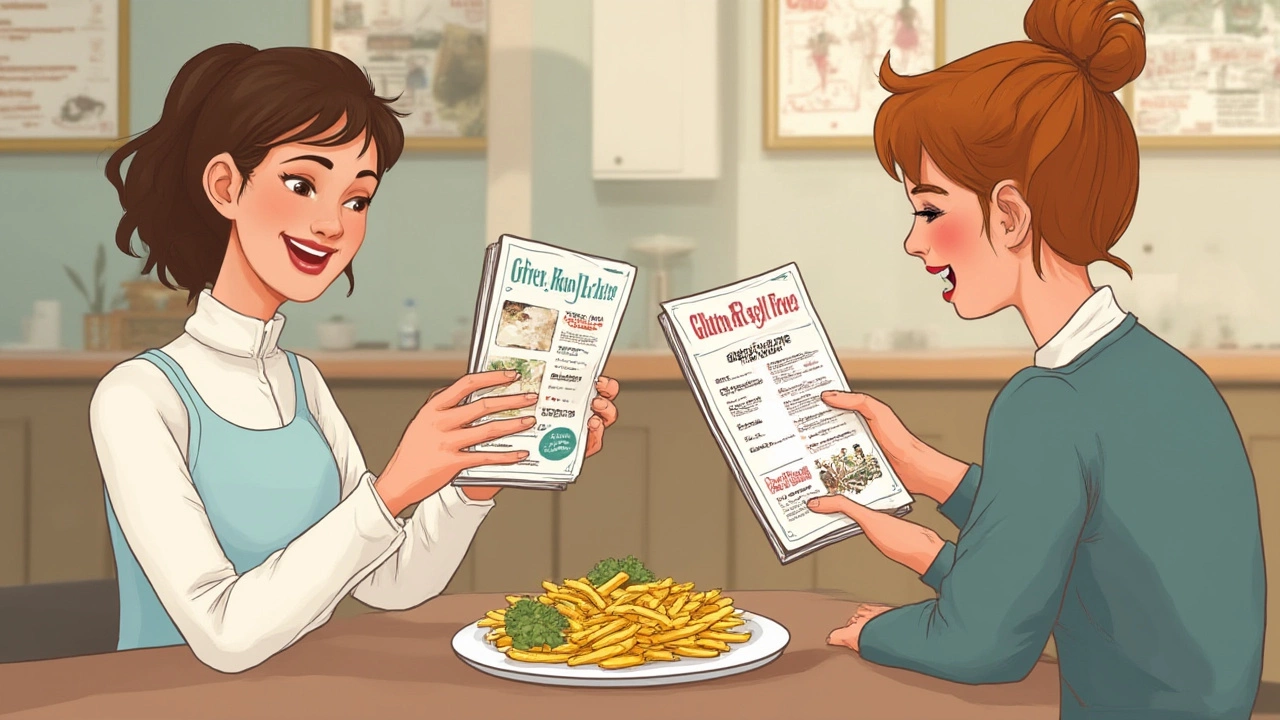Biting into crispy, golden home fries hits differently when you’re gluten sensitive or have coeliac disease. The big question isn’t just ‘are potatoes gluten free?’ That’s easy—yes. But home fries are rarely just potatoes. Unless you’re making them at home, you might never really know what else sneaks into that pan. These days, gluten sneaks up in the weirdest places, hiding behind labels that sound innocent. One batch of restaurant home fries can be safe, the next could trigger a week of misery. Let’s uncork the facts—there’s more than meets the eye with this diner staple.
What Exactly Are Home Fries?
First up, let’s cut through the confusion: home fries aren’t the same as hash browns, French fries, or potato wedges, though they’re all basically spuds dressed up differently. Traditional home fries, especially in the UK and US diners, start life as chopped, diced, or sometimes sliced potatoes. These raw or parboiled chunks get pan-fried in oil or butter until they’re crisp outside and fluffy on the inside. Seasonings are broad—think salt, pepper, sometimes onions, garlic, paprika, and a green here and there. Occasionally you’ll see bell peppers tossed in for colour or a hint of heat.
Sounds straightforward, right? But there’s no strict recipe, especially when a chef wants to make things interesting. This is where the gluten question comes in, because home fries are about more than just potatoes. Let’s talk about where gluten might tag along for the ride.
Plenty of restaurant kitchens cut corners with “seasoning mixes” or batch-cooking practices that introduce wheat-based ingredients without anyone noticing. Some diners toss their potatoes in a very fine layer of flour or cornstarch to get maximum crispness. Others will splash a bit of Worcestershire sauce onto their pan, not realising that most English Worcestershire sauce contains malt vinegar, which isn’t gluten free. If you like home fries cooked on the same griddle as pancakes or battered fish, you’re probably looking at cross-contact. Even fancy aiolis or dipping sauces can bring gluten to the table.
It gets trickier in fast food spots and big chains, where supply chains change, staff training varies, and hidden ingredient lists get complicated. Want a stat that’ll stick? In a US survey from 2023, over 32% of restaurants admitted to using wheat flour or pre-mixed seasoning packets with gluten in their potatoes, just to keep things “crunchy and craveable.” At quick-service spots here in Manchester, home fries are often cooked alongside pastries or sausage rolls, so gluten crumbs fly.
Potatoes and Gluten: The Basic Science
Let’s pick apart the science before we venture into tips and tricks. Potatoes themselves contain zero gluten. Gluten is a protein only found naturally in certain grains—mainly wheat, barley, and rye. Pure, unprocessed starchy potatoes are always gluten free. That’s the one simple bit.
But potatoes become a blank canvas. Almost anything could go on or around them in a home fries recipe. There’s cornstarch and potato flour, both gluten free by nature, but then there’s regular flour, panko crumbs, wheat-based oils, and even bouillon cubes with wheat-derived “natural flavouring” that slips under the radar. The real culprit usually isn’t spuds but what’s added during cooking or seasoning—and the way they’re served.
It’s easy to think that anything fried is suspect, and you’d be right. The oil used to fry potatoes often gets shared. A fryer batch might start the day full of pure oil, but battered chicken or fish could take a plunge after, leaving gluten particles behind. It’s called cross-contact, and it’s why you should always ask about shared fryers at restaurants if you’re gluten sensitive or coeliac.
Home fries sometimes seem safer if they’re griddled or pan-fried instead of deep fried, but it’s only safe if that pan hasn’t already cooked up gluten-y foods. Some restaurants dust raw potato with seasoned flour before frying, as it clings to the oil and forms an extra-crispy coating. This practice is more common in North America, but even some English cafes do it for texture.
| Type | Typically Gluten Free? | Notes |
|---|---|---|
| Fresh potatoes | Yes | By themselves, no gluten |
| Pan-fried home fries (no additives) | Usually | Check for seasoning mixes/flour |
| Restaurant home fries | Maybe | Ask about shared pans and seasoning |
| Frozen/reheat home fries | No/Maybe | Check label for wheat, malt, or barley |
| Fast food breakfast potatoes | No | Often made in shared fryers |
“If you’re asking whether home fries are gluten free, you’re already paying closer attention than many chefs. But don’t take anything for granted in a commercial kitchen,” says health campaigner Sarah Sleet of Coeliac UK.
“Hidden gluten is still one of the main reasons people wind up sick from eating out. Always double check, no matter how simple the food seems.”

How to Enjoy Gluten Free Home Fries Safely
Your kitchen is probably the safest spot for gluten free home fries. All you need is some basic kit: a sharp knife, a nonstick or cast iron skillet, and a reliable way to scrub potatoes. Russets get you the classic home fry texture with crispy edges and pillowy bites, but waxy potatoes hold their shape and won’t go mushy if you want chunkier cubes.
Here’s a foolproof recipe for gluten free home fries:
- Peel or scrub six medium potatoes (Maris Piper or King Edward are my favourites here in the UK).
- Chop into half-inch cubes, then rinse under cold water to remove excess starch.
- Parboil cubes in salted boiling water for 4–5 minutes, drain, then spread out to steam off extra moisture.
- Heat two tablespoons of oil (olive or sunflower) in a skillet. If you want, mix with a bit of butter for rich flavour. Don’t use vegan butter spreads unless they’re certified gluten free; some contain wheat derivatives as stabilisers.
- Add sliced onions or peppers if you fancy. Toss in potatoes and season with salt, pepper, paprika, and your favourite dried herbs.
- Fry on medium, flipping occasionally, until crispy and browned—about 10–15 minutes.
- Serve hot with a squeeze of lemon or a dollop of sour cream.
Avoid spice blends with “anti-caking agents”—they sometimes pack wheat flour as a bulking agent. Single spices and pure herbs are safest. Even some smoked paprikas sneak in wheat to keep the powder separated, so the best option is reputable brands marked gluten free.
If you’re buying frozen home fries, always hunt for a gluten free label. In the UK, more brands have started marking their potato products with a “Crossed Grain” symbol approved by Coeliac UK. That’s no guarantee for eating abroad, though—US and EU labelling varies a lot, and smaller producers aren’t always aware that starches and flours can trip people up.
Not sure about your local greasy spoon? Ask the chef these three things:
- Do you dredge your potatoes in flour before frying?
- Are your potatoes cooked on a clean surface or shared with flapjacks or battered foods?
- Can I see the label on your seasoning mix?
That one awkward conversation could save you a rough week. Staff in good places will welcome the question—if they don’t, that tells you what you need to know.
When eating out, it’s safest to skip home fries unless the kitchen is certified gluten free. Some high-quality cafes and restaurants in bigger UK cities cater to coeliacs specifically, making their potatoes in separate pans and using fresh seasoning. In Manchester, try The Allotment or Greens for reliably safe gluten free breakfast potatoes.
If you fizzle out at buffets or brunches, bring your own home fries in a heat-safe container. Every serious coeliac in Britain’s got a story about surprise gluten at a family breakfast, with shared tongs or sneaky butter used on toast and potatoes alike.
Hidden Gluten: What to Watch For
Let’s pull back the curtain on the real troublemakers. Home fries pick up gluten in one of four ways: flour dusting (for texture), industrial seasoning blends, cross-contact, and coated toppings like gravy or fake cheese sauce. If you’re new to gluten free eating, the first three are easy to miss.
About that flour dusting: some chain restaurants and quick-serve diners in the UK and US add flour to brown up potatoes. It’s not always listed—kitchen staff think of it as an old trick, not an ingredient. If you spot suspiciously shiny or extra-crisp potatoes, treat with caution. Glazed, crunchy outsides often mean some extra coating, and rarely does it come from cornstarch alone.
Seasoning blends make things complicated fast. Spice mixes, especially “house blend,” “spiced salt,” or even “fajita seasoning” can hide wheat flour or maltodextrin derived from wheat. MSG is gluten free itself but can be blended with wheat-based flavour carriers. Ask for the tub or packet to double check. Popular UK brands like Schwartz and Bart officially label gluten content, but in-house blends rarely get checked for allergens.
Cross-contact is the ultimate wildcard. Shared fryers, spatulas, tongs, or even storage containers can mean gluten gets where it shouldn’t. This is rampant in busy kitchens at brunch hours. In a 2022 Manchester survey, 44% of tested “gluten free” potato dishes at local cafes contained enough gluten to trigger a coeliac response—usually from shared oil or pans. That’s why home kitchens are safest, but you can still have a good experience if you ask the right questions out.
Gravies and dipping sauces are almost always off limits unless labelled gluten free. Most gravies start with a roux of butter and flour, which puts gluten straight into your potatoes. If you want a creamy dip with your home fries, go for Greek yogurt with chopped chive, or make your own quick sauce with mayo and gluten free sriracha.
It’s easy to think “natural flavouring” means safe, but that’s not always true. Brands sometimes use barley malt extract or wheat-based carriers—and UK rules only require brands flag wheat, not barley, when listing allergens. That’s why coeliac charities recommend reading the label on everything, every time.
Here’s a quick tip for kitchen survival: keep a Post-It note near your spices and mixes. Write “GLUTEN?” on it as a reminder to check every new packet you buy. You’d be shocked how many times a slipped-in seasoning ruins a gluten free meal without anyone realising it.
Last word? Stay sharp. Don’t panic if you crave home fries—just be as picky as you need to be, and treat new venues or packaged foods like potential problem zones unless you can confirm the facts. The world’s got enough stress—potatoes shouldn’t add to it.

